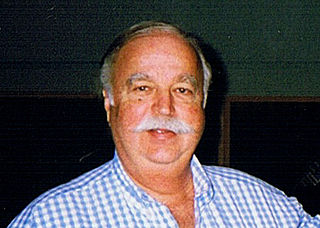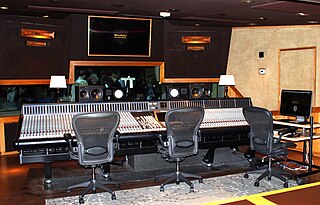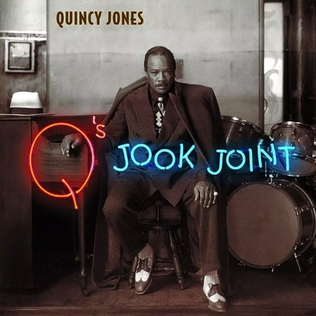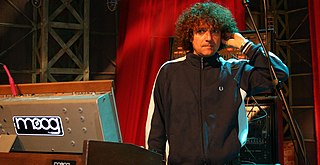
An effects unit, effects processor, or effects pedal is an electronic device that alters the sound of a musical instrument or other audio source through audio signal processing.

Audio mixing is the process by which multiple sounds are combined into one or more audio channels. In the process, a source's volume level, frequency content, dynamics, and panoramic position are manipulated or enhanced. This practical, aesthetic, or otherwise creative treatment is done in order to produce a finished version that is appealing to listeners.
TASCAM is the professional audio division of TEAC Corporation, headquartered in Santa Fe Springs, California. TASCAM established the Home Recording phenomenon by creating the "Project Studio" and is credited as the inventor of the Portastudio, the first cassette-based multi-track home studio recorders. TASCAM also introduced the first low-cost mass-produced multitrack recorders with Simul-Sync designed for recording musicians, and manufactured reel-to-reel tape machines and audio mixers for home recordists from the early 1970s through the mid-1990s. Since the early 00's, TASCAM has been an early innovator in the field-recording and audio accompaniment to video with their DR-series recording platforms. TASCAM celebrated its 50th anniversary in 2021.

Back on the Block is a 1989 studio album by Quincy Jones. The album features musicians and singers from across three generations, including Ella Fitzgerald, Miles Davis, Joe Zawinul, Ice-T, Big Daddy Kane, Sarah Vaughan, Dizzy Gillespie, George Benson, Luther Vandross, Dionne Warwick, Barry White, Chaka Khan, Take 6, Bobby McFerrin, Al Jarreau, Al B. Sure!, James Ingram, El DeBarge, Ray Charles and a 13-year-old Tevin Campbell.
Record One is a recording studio complex in the Sherman Oaks neighborhood of Los Angeles, California. Originally founded in 1979, the studio has been the site of numerous commercially successful and award-winning recordings. Since 2015, Record One has been under the ownership of Dr. Dre and his business partner Larry Chatman.

Hal Leonard LLC is an American music publishing and distribution company founded in Winona, Minnesota, by Harold "Hal" Edstrom, his brother, Everett "Leonard" Edstrom, and fellow musician Roger Busdicker. Currently headquartered in Milwaukee, Wisconsin, it is the largest sheet music publisher in the world. It is now part of Muse Group.

Automated Processes Inc. is an American company that designs, manufactures, and markets mixing consoles and signal processors, including modular signal processor units in the 500-series format standard that evolved from early API mixing consoles.

Bruce Swedien was an American recording engineer, mixing engineer and record producer. He was widely known for his work with Michael Jackson, Quincy Jones, Paul McCartney and Barbra Streisand.

Westlake Recording Studios is a music recording studio in West Hollywood, California.
Universal Recording Corporation was a recording studio in Chicago founded by Bill Putnam, Sr. for the purpose of investigating new recording techniques and the development of specialized recording equipment.

Q's Jook Joint is an album by Quincy Jones, released in 1995 by Qwest Records. The album reached No. 1 on the Billboard jazz albums chart on December 30, 1995. Q's Jook Joint won the Grammy Award for Best Engineered Album, Non-Classical in 1997.
Lonnie Park is an American record producer, composer and musician based in Freeville, New York. His work has received three Grammy Awards and four Grammy Nominations, Global Peace Song Award, Global Music Award, multiple SAMMY Awards, and the United Nations Action Award.

An audio engineer helps to produce a recording or a live performance, balancing and adjusting sound sources using equalization, dynamics processing and audio effects, mixing, reproduction, and reinforcement of sound. Audio engineers work on the "technical aspect of recording—the placing of microphones, pre-amp knobs, the setting of levels. The physical recording of any project is done by an engineer…"

E.T. the Extra-Terrestrial is an audiobook and soundtrack companion album for the 1982 film directed by Steven Spielberg. Composed by John Williams, the album was narrated by recording artist Michael Jackson, produced by Quincy Jones and distributed by MCA Records. The audiobook was produced by John Williams and Michael Jackson working with Rod Temperton, Freddy DeMann, and Bruce Swedien.

Anthony Marinelli is an American musician, composer, synth programmer, record producer and conductor. In his early career, he composed and performed accompaniment on the synthesizer for albums including Michael Jackson's Thriller (1982). Marinelli has also recorded with Lionel Richie, Kenny Loggins, Herb Alpert, Supertramp, The Crystal Method, Billy Childs and James Brown.
"The Secret Garden (Sweet Seduction Suite)" is a song by Quincy Jones, featuring Afro-American R&B singers Al B. Sure!, James Ingram, El DeBarge, and Barry White. It was released as a single from Jones's album, Back on the Block (1989), and peaked at number one on the Billboard Black Singles chart for one week in 1990. It also reached number 31 on the Billboard Hot 100, number 26 on the Adult Contemporary chart, and number 67 on the UK Singles Chart. "The Secret Garden (Sweet Seduction Suite)" was written by Jones, Rod Temperton, Siedah Garrett and DeBarge and produced by Jones.

A matrix mixer is an audio electronics device that routes multiple input audio signals to multiple outputs. It usually employs level controls such as potentiometers to determine how much of each input is going to each output, and it can incorporate simple on/off assignment buttons. The number of individual controls is at least the number of inputs multiplied by the number of outputs.
Jim Klein is a Los Angeles born, Philadelphia-based, Emmy Award-winning composer, music producer, recording engineer, and songwriter. Klein is best known as the producer and songwriter behind the influential freestyle group Pajama Party, whose albums produced several hit singles. He is also a published author.

Peter Wade Keusch, more commonly known as Peter Wade, is a record producer, recording engineer, mixer, songwriter and A&R. His artist development projects include MNDR, Party Nails and numerous songwriters and producers signed to his record label WonderSound and publishing company 120 Music. Wade's production and writing credits include Kid Ink, Jennifer Lopez, Martin Solveig, Kylie Minogue, and Flume.
Thomas Vicari is an American recording engineer, mixing engineer, record producer and scoring mixer known for his work with Quincy Jones, Gino Vannelli, Nicholas Britell, Thomas Newman, Prince, George Duke and Barbra Streisand. He was the sound mixer for TV shows and films including Six Feet Under, The Newsroom, Behind the Candelabra, Phantom of the Paradise, Finding Nemo, Finding Dory, Wall-E and Road to Perdition.












